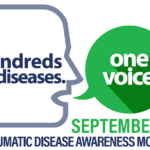We’ve also learned that we need to focus on specific areas of rheumatology in this campaign. With the term arthritis used as an umbrella term for more than 100 diseases and conditions, we need to help our target audiences focus with easily digestible information that will show them the severity of our diseases, why we are the experts in diagnosis and treatment, and the importance of supporting our specialty. With this in mind, the campaign’s first phase focuses on how inflammatory rheumatic diseases attack, disable, and threaten the lives of those living with them, and it sheds light on the role rheumatologists play in rheumatic disease diagnosis and treatment.
The Marathon Ahead
Not only do we need to be focused in this campaign, we need to sustain our efforts—preparing for a marathon, not a sprint, will serve us well in the long run.
We know, through our ongoing advocacy efforts and through working with referring physicians in our practices, that a sustained effort is necessary to create change. We cannot visit Capitol Hill once every five years and expect great legislative outcomes; we cannot reach out to referring physicians the first month our practices open and expect they will remember why it is important to refer people with rheumatic diseases to us; and we cannot dabble in public relations and expect target audiences to value rheumatology. We have to sustain our efforts and provide regular communication, education, and outreach in all of these areas—thus the initial five-year commitment the ACR has made to this campaign.
When we see pink ribbons for Breast Cancer Awareness Month (and pink phones, blenders, t-shirts, etc.), we must remember that that is years in the making. … It will take time for our campaign to gain traction, and we will see small and large movements toward the end result during the next several years.
When we see pink ribbons for Breast Cancer Awareness Month (and pink phones, blenders, t-shirts, etc.), we must remember that that is years in the making. Organizations like Susan G. Komen for the Cure have been in the PR game for a long time. They all took first steps, launched inaugural PR campaigns, and (it is likely) they all came to understand that they’ve entered a marathon, not a sprint. As it did with these organizations, it will take time for our campaign to gain traction, and we will see small and large movements toward the end result during the next several years. Viewing this campaign as a sustained, focused effort will give us the patience needed for the long haul and the preparedness needed for our next steps.
A Willingness to Keep Going
In five years, with $3.75 million spent wisely, we expect to make good headway with these audiences. By this point, they should have increased knowledge of who we are, what we do, why rheumatology is important, and how to engage with us. How far do we go after that? I imagine this initial commitment will yield results that don’t take us to an endpoint but that will instead open doors to new PR opportunities for our specialty.
